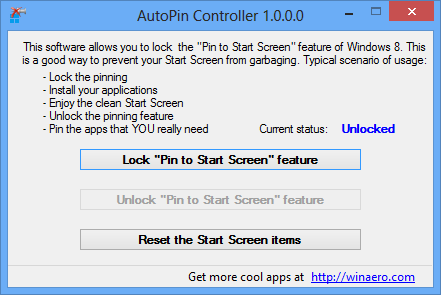If you have been using Windows 8, you would definitely have noticed that it automatically pins every application shortcut to the Start screen. This is highly unwanted behavior because your Start screen will become cluttered very quickly. Today I would like to share with you a simple and useful trick which will give you a clean and well organized Start screen. Continue if you are interested.
Advertisеment
By default, Windows 8 does not come with any option to disable the auto pinning option. Microsoft has left no choice for the end user.
Under the hood, the Start screen keeps almost all data related to pinned apps and tiles in the following file:
%LocalAppData%\Microsoft\Windows\appsFolder.itemdata-ms
You may also use the following trick to locate that file:
- Press Win+R keys on your keyboard. The "Run" dialog will be displayed on the screen.
- Type the following:
shell:Local AppData
Tip: you can get the full list of shell commands from here: The full list of shell commands in Windows 8.
- An Explorer window will appear, navigate to Microsoft\Windows folder and you will see the appsFolder.itemdata-ms file.
As mentioned above, this file is key to your Start Screen content.
For example, if you delete this file, and sign out and sign in back to Windows, you will get a clean Start screen with default tiles, just like you got at first logon!
But, we are interested in preventing the Start Screen from getting cluttered, so obviously, it must preserve all customized tiles and manually pinned app shortcuts. The best way to do this is to make a backup of the appsFolder.itemdata-ms file and restore it after you have installed the apps you want to pin. Follow these simple steps to do it right:
- Get an alternative file manager. You need one because this file is locked by Explorer. I can recommend you Explorer++, Total Commander or FAR Manager.
- Configure the Start screen the way you like - pin built-in or already installed apps, unpin everything you don't need, add Tiles for Modern apps and so on.
- Exit Explorer. Please refer the article: "How to properly restart the Explorer shell in Windows" to learn how it should be done.
- Make a backup of two files:
%userprofile%\AppData\Local\Microsoft\Windows\appsFolder.itemdata-ms
%userprofile%\AppData\Local\Microsoft\Windows\appsFolder.itemdata-ms.bak
It is very important to make a backup of the second file too, so don't forget that.
- Start Explorer again, install new apps (they will be pinned automatically because of the oversmart auto pinning behavior of Windows 8).
- Run the alternative file manager app.
- Exit the Explorer shell again. Copy the appsFolder.itemdata-ms file and appsFolder.itemdata-ms.bak file that you have from step 4 back to the %userprofile%\AppData\Local\Microsoft\Windows\ folder with alternative file manager.
- Start the Explorer shell, and you will get your personalized, clean Start screen back.
That's it.
Now, if you regularly install a bunch of new apps every few days, doing all these steps can be very tiresome. So I have automated this process, and created the "AutoPin Controller" utility to resolve this problem.
It does not create a backup of the above mentioned files. Instead, it changes the access rights to the appsFolder.itemdata-ms file and also creates a appsFolder.itemdata-ms.lock file which tells Windows 8 Explorer shell that the Start Screen should not be updated/changed.
You can try AutoPin Controller from here: Download AutoPin Controller
Note that it is not perfect: sometimes Windows still pins certain shortcuts with a delay after you unlock "Pin To Start Screen" feature. I plan to rewrite the utility to make it use the "backup/restore" method and resolve the issue.
I hope that this article is useful to anyone who prefers a clean, well organized Start screen. Feel free to share your opinion on the Start screen's "oversmart" behavior in comments.
Support us
Winaero greatly relies on your support. You can help the site keep bringing you interesting and useful content and software by using these options:

